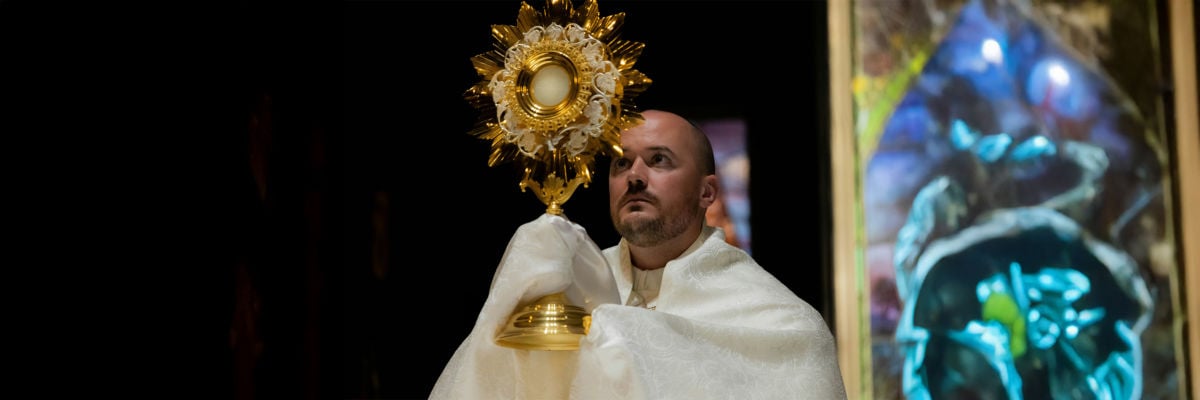
Audio only:
A follow up to his video, “Why Liberal Catholicism Is Dying,” Joe examines the results to a follow up study on priests in America, which results show some good, some bad and some ugly.
Transcript:
Joe:
They interviewed more than a thousand priests. It doesn’t appear they got anyone saying that they were extremely liberal. There is this sea change of orthodoxy coupled with compassion, but that’s the good news. Let’s talk about the bad news. The bad news is young priests are burning out. Welcome back to Shameless Popery. I’m Joe Heschmeyer, and today I want to briefly share the good, the bad, and the ugly about the future of the priesthood in the Catholic church in America. And I’m going to be looking at the 2025 report by the Catholic Project. If you’re not familiar, this is a group out of CUA Catholic University of America where they did a massive study looking at Catholic priests in 2022, did a large survey of several or a few thousand priests and then they were able to get follow up more in depth survey results in 2025 with 1,164 of those original priests.
So this let them go a little deeper. You may remember I did an episode earlier looking at young priests at a very broad level showing younger and newly ordained priests are way more politically conservative and way more theologically, orthodox and older priests. But here they went a little more in depth. So let’s us get a better view of what that concretely means because terms like orthodox and conservative could mean a lot of things to a lot of people. And so we now have I think a fuller, more nuanced picture. So I want to do something of a follow-up episode and then I’ll link to the original episode at the end of this one just exploring the good, the bad and the ugly because I think there’s some really good signs, but I think we would be lying if there weren’t some things that are also alarming about the picture facing young priests.
And I think the silver lining from that is there are things you and I can concretely do. So with that said, let’s start with the good. There is this sea change of orthodoxy coupled with compassion. I don’t mean to say that compassion is new. I mean to say that the kind of theological orthodoxy we have is not some cold pharisaic rigors, but rather we see something like a bleeding heart Catholic orthodoxy, which is great. It’s exactly what we would want from our priests. These study authors talk about, as I alluded to this massive generational shift and we see it both in political and in theological views. I’m much less interested in the political, much more interested in the theological, but these are both too big not to mention. So in both the 2022 and the 2025 study, we see again these huge shifts. So priests who were ordained before 19 75, 60 1% considered themselves either very or somewhat politically liberal.
Only 15 or fewer than 15% consider themselves politically conservative. Now if you compare that to those ordained since 2010, those who consider themselves somewhat or very conservative went from 15% to 51%. And meanwhile, the number of people considering themselves politically liberal has dropped to about 11% of priests ordained in the last 15 years. So there is this massive shift, and in fact even there that 11% is only priests who consider themselves somewhat liberal in that cohort, remember they interviewed more than a thousand priests. It doesn’t appear they got anyone saying that they were extremely liberal or very liberal. Maybe they did. There’s no number for the dark blue in that figure. So it looks like the radical left wing kind of priest is simply a thing of the past, and I’ve mentioned that before, but I’m much more interested in the theological trajectory because like it or not, there is a clear connection between the self-described politically liberal and the theologically progressive or less orthodox, more heterodox or heretical priests.
I don’t know a better way to put that, but we see this also has a massive generational bent to it as well. Among priests ordained before 1975, more than 70% describe themselves as theologically progressive. These days priests ordained in 2010 or later only 8%. And I wish there was a chart for this because I think the more you press someone on whether they’re extremely progressive, et cetera, you just see this total collapse that the radical, let’s question everything. Theology that you sometimes would get from left-wing priests, sometimes they’ll still get from older kind of baby boomer priests. It doesn’t draw anyone to the priesthood, and we can say that pretty definitively. Now by contrast, the young priests, over 70% of them consider themselves conservative or orthodox theologically or else very conservative slash orthodox. Only about 20% of them even consider themselves kind of theologically middle of the road.
Now, again, this leaves a lot of questions about what that actually means, but I think we can take a closer look at a few things. Number one, it doesn’t mean they’re just blindly supporting whatever the Trump administration says because remember, you’ve got a lot of people who consider themselves conservative priests and that might be sounding alarm bells for people saying, well, what about all the bad stuff? What about sometimes inhumane crackdowns with ice and everything else? And it’s worth at least pointing out that it doesn’t appear that these priests are just blindly partisan. They are putting Phil of Jesus Christ first, at least in terms of their own self-reporting. Two thirds of priests who identified as very conservative still said they were at least somewhat concerned about the Trump administration’s policies among priests who identified themselves as conservative young priests who identified themselves, oh no, sorry, that’s all priests who identified themselves as conservative.
83% still said that they were concerned about Trump administration policies. So don’t hear conservative to just mean these are MAGA priests who will just co-sign whatever the administration does. It’s clear that they’re obviously going to be more conservative on some prudential issues, but it doesn’t seem like they’re doing this just blindly. In terms of the theological shift and what all this means, pastorally, Luke Kain, who has a good analysis of this in the pillar points out that the priestly priorities are really notable here. Only 11% of the priests ordained before 1980 said access to the traditional Latin mass should be a priority compared with 20% of those ordained between 1980 and 1999. So you see it basically doubles from about 10% to about 20% and then basically doubles again to almost 40% because 39% of those ordained in the 21st century think access to the traditional Latin mass should be a priority.
They’re also these younger priests more likely to focus on eucharistic devotion as a priority and less likely to focus on things like climate change, immigration, LGBT issues, poverty, racism, and social justice. There is one particular chart that I think drives all of this home. It’s figure 12 in the 2025 report, and it might be too small for you to see on the video, but if you pull up the report, you can see each of these issues and they just ask priests which things they can consider a priority. And I’m going to get more into that in a second, but I want to compare two issues, L-G-B-T-Q community versus access to traditional Latin mass. Now look, I think there’s a perfectly orthodox way of saying yes, people who are same sex attracted need to be ministered to, et cetera, and so just because someone says it’s priority or it doesn’t tell you what they think ought to happen, nevertheless, this is going to be a notable shift because among the oldest generation, those ordained before 19 80, 60 6% of them considered the L-G-B-T-Q community a priority, whereas the TLM community only 11%, so it’s a six to one variation, they’re six times more likely to regard the L-G-B-T-Q outreach as a pastoral priority and not Latin mass.
In contrast, among the priests ordained in the last 25 years, that six to one ratio has disappeared. They’re actually slightly more likely to treat the TLM as a pastoral priority 39 to 37%. So it’s about a one-to-one ratio now instead of a six to one ratio. Again, it’s a massive change. And so if you’re wondering what’s the future of the liturgy going to look like, well imagine when those people become bishops because in many of these cases, these priests are too young to be seriously considered its bishops, but this is the future of the diocese in America that this is what a lot of pastoral governance is going to look like a generation or two from now. So you can see on all sorts of issues, they’re less concerned about climate change, less concerned about immigration, less concerned about L-G-B-T-Q. They’re slightly less concerned about poverty, homelessness, and food insecurity, although still pretty concerned about it.
They’re more concerned about eucharistic devotion, more concerned about access to the TLM. They’re less concerned about racism and social justice, although still pretty concerned about social justice and they’re not particularly concerned about ality. So that’s kind of a data dump, but it should give us a little bit more of a sense of what does it mean when we hear that these young priests are theologically and politically conservative and orthodox. There is a cudgel that you might hear, which is, oh, well these guys, they hate the pope. They’re dissenting from the Pope and they dislike Pope Leo and et cetera, et cetera. And in the numbers, we just don’t see that as true overall, 86% of priests said that they had either quite a lot or a great deal of confidence in Pope Leo the 14th. Now, granted, this is over the summer. This is in kind of his papal honeymoon period, but that’s still massive.
And another 13% said they had some confidence. Only 1% of priests said they had very little confidence. That’s really good. That’s a really good sign. Additionally, most believed that relationships between the Vatican and the US would improve under polio. 28% said it would improve significantly. 51% said it would improve somewhat, only 3% thought it would get worse. Only 17% thought it would save the same. So four out of five of priests are just like, yeah, could and good for the church in the us. I want to go back now to that issue about priorities in the American church. Across the board. Priest think that we need to focus on young adult ministry, family formation, marriage prep, evangelization. These aren’t politically hot button, these aren’t controversial. These aren’t cross-generational or political in any way. So people don’t talk about this, but those are big things and those are things that priests are rightly focused on.
These are followed pretty closely by concerns for poverty, homelessness, food insecurity, as well as pro-life issues. Then following that, you have immigration, Hispanic slash Spanish language ministry, social justice, then eucharistic devotion, then racism, then artificial intelligence, which I thought was actually pretty fascinating to see it score as high as it did, followed by climate change slash ecology, ality, L-G-B-T-Q, and then finally access to the traditional Latin mass. But again, on that final one, remember there’s an enormous generational divide. So I think that the access to the TLM is going to rise in the ranks of priority as you get a lot of these younger priests becoming older. I think it’s also maybe helpful to hear the kind of things that priests are grappling with. Those are a bunch of different really big issues, really important issues that people want a good Christian witness on, and they often want a good Christian witness on from the priest.
And so just bear that in mind. Whatever your particular issue is that your pastor or your bishop may be trying to be a good witness and a good steward, a good advocate for a bunch of other really important issues as well. So maybe cut ’em a little slack. Now, in the 2025 report, there is one part I didn’t love, which is they compared which things these different priests saw as a priority and which things they actually had a ministry for. And so only 6% of priests actually had an L-G-B-T-Q Ministry. Okay? I get what they’re doing there. But with an evangelization for instance, they’re less likely to have evangelization ministries than they’re to have pro-life ministries. There’s something worth exploring there like where we put in our actual time, money, and energies. But I have some caveats with it, and I have caveats because of Pope and John Paul ii, who I’m recording this on Wednesday, it’s his thief day.
He warns that we’re not saved by a magic formula. We’re saved by a person, Jesus, who says, I’m with you, and therefore we don’t need to go out and invent a new program. Rather, the program as it is, is simply the gospel and it’s living tradition. It’s ultimately centered in Christ himself. And this is a program which doesn’t shift with times and cultures. You don’t have a generational divide for who Jesus applies to. Okay, that’s a lot, but that’s the good news. Let’s talk about the bad news. The bad news is young priests are burning out at a remarkably high rate. This is something that I think we need to take very seriously. Now to measure this, they ask priests to agree or disagree with the following statements. It happens more and more often than I talk about my ministry in a negative way during my ministry work.
I often feel emotionally drained and I usually feel worn out and weary after my ministry work. So you can measure for yourself whether those are good or bad kind of questions to ask. But those are the questions they’re asking. And what they find is that diocesan priests are more likely than priests and religious orders to be burnt out. 7% of diocesan priests report having high burnout using this kind of method compared to only 2% of priests in religious orders in terms of having at least some burnout, 44% of death and priests report being at least somewhat burnt out compared to 31% of those in religious orders. That’s already going to be our first indication that this is at least largely about the amount of work we’re putting on the shoulders of our priests. And we also see a big generational gap. So in response to the prompt, I’m expected to do too many things that go beyond my calling as a priest.
Older priests, only 13% said yes to that among those who ordained 2000 or later 45%. That’s huge, and that’s worth exploring. So it raises this question, well, is this an issue of too much being put on the shoulders of younger priests or are they just expecting not to do things that the older priests knew they were going to have to do? One of the priests interviewed in the report talks about how he’s extensively helping with vocations, youth camps, local charities, that he works 60 to 70 hours. He doesn’t really, he will often go weeks with no real day off, and he puts an average of 20,000 miles on his car per year. Those are things I think we should be watching out for because this is one of those things that can come back and bite us in a big way. As the report says, one explanation is that priests are just being asked to do more and that a lot of young priests, one indication of this is a lot of young priests are serving in multiple parishes significantly.
There wasn’t an actual relationship that they could measure between the number of parishes a priest was serving in and burnout, which at least anecdotally I would say makes sense for this reason that at least in the diocese, archdiocese of Kansas City, Kansas, the diocese, I know the best, the large parishes are way more taxing. There’s a lot more things going on every night of the week. And then you go out into rural Kansas and you might have two or three parishes that are kind of in a general geographic region. So you might be in the car more than you would in the suburb, but your number of people you’re ministering to is a lot fewer. It’s a much more manageable workload. You might actually be bored rather than overwhelmed. In any case, I think this is something we need to take very seriously, that priests are burning out, and we don’t want to tax young priests to such an extent that they end up wanting to leave ministry.
Something like 3% of the priests they surveyed had considered leaving ministry. That’s relatively low, but it’s still too high, and that number could go up in a heartbeat because someone just has a really horrible month or two. So I would just say for the laypeople watching this, try to find ways of making your priest’s life a little easier, particularly if this is a priest who has a lot on his plate, so that’s the good and the bad. Let’s get to the ugliness, which is the ugliness of loneliness. And this is an epidemic I would suggest nationwide, but priests are not immune from it. And also if they’re overworked and they’re living alone, they might be particularly susceptible to this. So the questions that they asked was actually based on, I believe, A-U-C-L-A study on loneliness. The questions are, how often do you feel that you lack companionship?
How often do you feel left out, and how often do you feel isolated from others? And you score each of those from one to three from not very often to a lot. And so if you have a score of six or higher cumulatively, so if you do 1, 1, 1, only be three, you do 3, 3, 3, that’d be nine, that’d be the most lonely you could be. So a six or above, they rank you as lonely. In terms of loneliness, 27% of the older generation of priests considered themselves lonely, then they may not have used that word, but in terms of how they answered the questions, that skyrockets to 45%. So these two things, the burnout and the loneliness, I think we need to tackle together and say, these are good priests with the heart for Jesus Christ, who are striving to live out orthodoxy in a compassionate way, and we should do more to make their lives a little easier.
So it may be as simple as if you are on good, friendly relations with a priest, let them come over and just have a meal or test some time away. Sometimes that’s extra work. Know your priest well enough. Are they an introvert, an extrovert? How do they like to unwind? But if there are ways of making their life a little easier, you can bond with them, connect with them. You can help with both the burnout and the loneliness. And please, as a final bit of advice, pray for priests because they are targets spiritually. They’re susceptible to all of the temptations and everything else, everyone else’s, and we need them for the future of the church. Now, as I mentioned, I recently did a video exploring the 2022, so if you want to hear more about the political and theological shifts, you can check that out over here. I hope you enjoy that much deeper dive. Alright, for Shameless Popery, I’m Joe Heschmeyer. God bless you.



